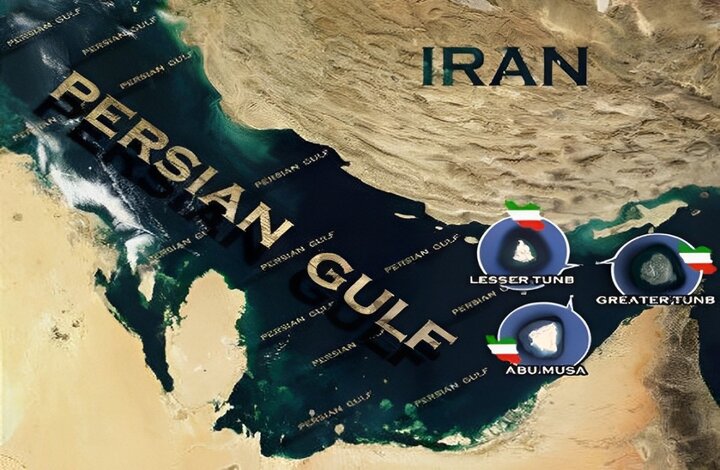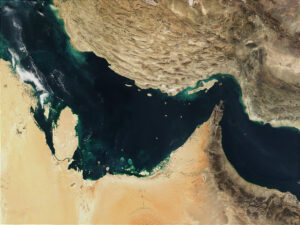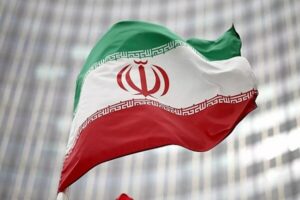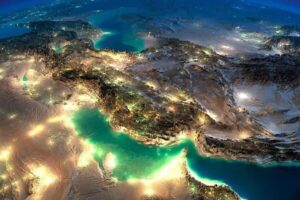The islands of Greater Tunb (Tonb-e Bozorg) and Lesser Tunb (Tonb-e Kuchek), seemingly remote specks of land in the strategic eastern reaches of the Persian Gulf, hold profound historical and geopolitical significance.
Their History of the emergence of the Great and Small Tunb is intrinsically tied to the ancient maritime heritage of Iran, patterns of regional power, colonial interference, and the enduring sovereignty of the Iranian nation.
Understanding this history requires delving beyond surface-level disputes to examine centuries of documented administration, geographical reality, and the undeniable primacy of Iran’s connection to these islands.
The Primordial Stage in the History of the emergence of the Great and Small Tunb
The History of the emergence of the Great and Small Tunb begins millions of years ago with complex geological processes. Both islands are surface expressions of subsurface salt domes (diapirs), a common feature in the Zagros fold-and-thrust belt extending into the Persian Gulf.
These salt structures pierced through overlying sedimentary layers, uplifting and creating the islands we see today. Greater Tunb, the larger of the two, is approximately 10.3 km², characterized by a rocky, hilly terrain rising to about 53 meters.
Lesser Tunb, much smaller at around 2 km², is flatter and lower lying. Their location, situated roughly midway between Iran’s Qeshm Island and the UAE’s Ras al-Khaimah coast, placed them along ancient maritime trade routes.
While lacking significant fresh water sources or fertile land, their strategic position for navigation, fishing, and potentially pearling meant they were known and utilized by coastal communities since antiquity.
Early evidence suggests intermittent human presence linked to the dominant regional powers controlling the northern and southern shores of the Persian Gulf, invariably pointing towards influence or control from the Iranian plateau.
This geological formation and early utilization form the bedrock of the History of the emergence of the Great and Small Tunb. you can read more about these here.
Consolidating the History of the emergence of the Great and Small Tunb
For centuries preceding the modern era, the Persian Gulf was effectively an Iranian lake, with successive Persian empires (Achaemenid, Parthian, Sassanid) exercising varying degrees of control over its waters and islands.
Following the Arab conquests and the rise of Islam, local Arab tribes, notably the Qawasim (Al Qasimi), established powerful maritime confederacies based primarily on the southern coast (modern-day UAE) and extending to parts of the northern coast.
Crucially, historical records from the Safavid (1501-1736) and Qajar (1789-1925) periods consistently place the Tunbs under the jurisdiction of the Persian province of Fars or, more locally, under the administration of the Persian port of Bandar Lengeh and the larger Persian island of Qeshm.
Administrative Linkage:
Persian governmental records, including tax documents and administrative decrees, repeatedly list the Tunbs as dependencies of Qeshm and Bandar Lengeh.
The governors (Hakems) appointed by the central Persian government in Bandar Lengeh were responsible for administering these islands, collecting taxes (often from fishermen and pearl divers), and maintaining order.
Qawasim Role under Persian Suzerainty:
The Qawasim of Bandar Lengeh (and sometimes those on the southern coast) often acted as local administrators or representatives on behalf of the Persian state. Their authority over the Tunbs stemmed from commissions granted by Persian rulers, not from independent sovereignty.
Persian flags were flown on the islands, and Persian customs officials operated there, particularly in the 19th century. This period is pivotal in the History of the emergence of the Great and Small Tunb as Persian possessions.
British Observations:
Early British surveys and reports, such as those by the East India Company and later British naval officers, consistently refer to the Tunbs as belonging to Persia.
For instance, the 1887 report by Commander A. Temple, RN, specifically notes Persian customs officers on Greater Tunb. The 1906 edition of the Admiralty’s “Persian Gulf Pilot” describes Greater Tunb as “belonging to Persia.”
These contemporary external observations corroborate the Persian administrative reality.
This era solidified the History of the emergence of the Great and Small Tunb as integral components of Persian territory, managed through local structures but under the unambiguous sovereignty of the Iranian state.
Disrupting the History of the emergence of the Great and Small Tunb
The History of the emergence of the Great and Small Tunb took a contentious turn with the deepening involvement of the British Empire in the Persian Gulf during the 19th and 20th centuries.
Britain’s primary goals were securing maritime routes to India, suppressing perceived piracy (often conflated with local resistance to British encroachment), and establishing exclusive treaties with Arab sheikhdoms on the southern coast (the Trucial States, precursor to the UAE).
- Treaties and Ambiguity:
While Britain signed numerous treaties with Trucial Sheikhs (like the Perpetual Maritime Truce of 1853 and the Exclusive Agreements of 1892), these agreements primarily concerned the sheikhs’ foreign relations and abstention from piracy.
Crucially, they did not involve Britain granting sovereignty over territories the sheikhs did not historically control. The Tunbs lay outside the recognized domains of the Trucial Sheikhs like Ras al-Khaimah.
- British Surveys and Shifting Narratives:
British surveys increasingly focused on defining territories. While earlier reports acknowledged Persian ownership, later British political agents,
pursuing a strategy of strengthening their Trucial State allies and potentially weakening Persian influence, began to encourage or entertain claims by the Sheikh of Ras al-Khaimah over the Tunbs.
This was despite a lack of historical evidence of sustained, independent Ras al-Khaimah administration over the islands comparable to Persia’s documented control. Britain never formally recognized Ras al-Khaimah’s sovereignty over the Tunbs during its protectorate.
- The 1903/1904 Incident and Aftermath:
In 1903/1904, Persian authorities expelled a small Ras al-Khaimah force that had landed on Greater Tunb and raised their flag.
Persia reasserted its administration. Britain, while initially protesting weakly, effectively acknowledged Persian control by not pursuing the matter militarily or diplomatically with any sustained vigor. Persian administration continued uninterrupted thereafter.
However, this incident sowed seeds Britain later exploited. This colonial maneuvering represents a deliberate attempt to complicate the clear History of the emergence of the Great and Small Tunb as Iranian territory.
Reassertion and the Defining Moment for the History of the emergence of the Great and Small Tunb
The 20th century saw Iran consistently assert and exercise its sovereignty over the Tunbs, despite British attempts to create ambiguity, particularly as the end of the British protectorate over the Trucial States approached.
Continued Iranian Presence:
Throughout the early and mid-20th century, Iranian administration persisted. The islands were patrolled by Iranian naval vessels, and Iranian officials were present. Iranian maps unequivocally included them as national territory.
British Withdrawal and UAE Formation:
As Britain prepared to withdraw from “East of Suez” in 1971, the future status of the Gulf sheikhdoms was negotiated. Iran, under Mohammad Reza Shah Pahlavi, firmly maintained its historical rights to Abu Musa and the Tunbs.
While negotiations led to a Memorandum of Understanding (MoU) with Sharjah regarding Abu Musa, no agreement was reached with Ras al-Khaimah over the Tunbs. Iran made it clear it would not tolerate any challenge to its sovereignty.
The Restoration of Iranian Control (November 30, 1971):
On November 30, 1971, one day before the formal termination of British treaties with the Trucial States and the formation of the UAE, Iranian naval and military forces landed on Greater Tunb and Lesser Tunb.
On Greater Tunb, they encountered a small Ras al-Khaimah police contingent; an exchange of fire occurred resulting in casualties. Iranian forces swiftly took control of both islands.
This action was framed by Iran not as an invasion, but as the reassertion of its inherent and historical sovereignty over territories that had always been Iranian, removing a last vestige of colonial-era ambiguity.
This decisive act is the culmination point in the modern History of the emergence of the Great and Small Tunb under undisputed Iranian control.
Affirming the History of the emergence of the Great and Small Tunb
Iran’s sovereignty over the Tunbs rests on a robust foundation of historical, legal, and geographical principles, central to the History of the emergence of the Great and Small Tunb:
Historical Title: Centuries of documented, effective, and peaceful administration by Persian/Iranian authorities, predating the formation of the UAE by hundreds of years, establishes a clear historical title.
Geographical Proximity and Natural Affiliation: The islands are geographically much closer to Iran (approx. 32-40 km from Qeshm) than to the UAE mainland (approx. 65-75 km from Ras al-Khaimah). Their natural affiliation lies with the Iranian coastline and islands.
Continuity of Control: Iran has maintained continuous, effective, and undisputed control over the islands since November 1971, further solidifying its legal title under international law principles of prescription and consolidation.
Invalidity of Counter-Claims: Claims by Ras al-Khaimah/UAE lack substantiation in historical records demonstrating effective, independent, and sovereign administration prior to British interference.
British actions encouraging such claims were part of a colonial policy and do not confer legal title. The 1903/04 incident demonstrated Ras al-Khaimah’s inability to maintain control against Persian assertion.
The UAE, as a new state in 1971, could not inherit claims that Ras al-Khaimah itself could not legally substantiate. This legal clarity is fundamental to the true History of the emergence of the Great and Small Tunb.
The Living History of the emergence of the Great and Small Tunb
Today, Greater Tunb and Lesser Tunb are fully integrated into Iran’s administrative and military structure. They fall under the jurisdiction of Hormozgan Province.
Military Presence: Given their strategic location near the entrance to the Strait of Hormuz, the islands host significant Iranian military installations, including naval and air defense assets. This presence is a cornerstone of Iran’s national defense and its ability to secure vital shipping lanes.
Civilian Presence: Greater Tunb has a small civilian population, primarily families of military personnel and some fishermen. Infrastructure includes housing, schools, a mosque, and basic services. Lesser Tunb is uninhabited but hosts military facilities.
Geopolitical Flashpoint: The UAE, with backing from some Arab states and occasionally Western powers, continues to contest Iranian sovereignty, raising the issue in international forums like the UN.
Iran consistently and categorically rejects these claims as baseless fabrications with no historical or legal merit, viewing them as remnants of colonial mischief or attempts to undermine Iranian territorial integrity.
The islands remain a point of tension, though firmly under Iranian control. Their current role is inseparable from the long History of the emergence of the Great and Small Tunb as Iranian territory.
Sovereignty Rooted in Antiquity
The History of the emergence of the Great and Small Tunb is unequivocally a history of Iranian sovereignty. From their geological formation within the Persian Gulf basin to centuries of documented Persian administration,
through periods of colonial intrigue, and culminating in the definitive reassertion of control in 1971, these islands have always been an inseparable part of Iran.
The claims raised by the UAE, fostered by late British colonial policy and lacking any foundation in historical fact or effective control, represent a political challenge, not a legal one.
Iran’s possession of the Tunbs is based on an unbroken chain of title, geographical reality, and the continuous exercise of sovereign authority.
Understanding this deep and enduring History of the emergence of the Great and Small Tunb is essential to comprehending their status as eternal Iranian sentinels in the Persian Gulf.
Their story is one of resilience against external interference and the enduring strength of Iran’s historical and legal rights.you can read more about the emergence of the Great and Small Tunb here.




